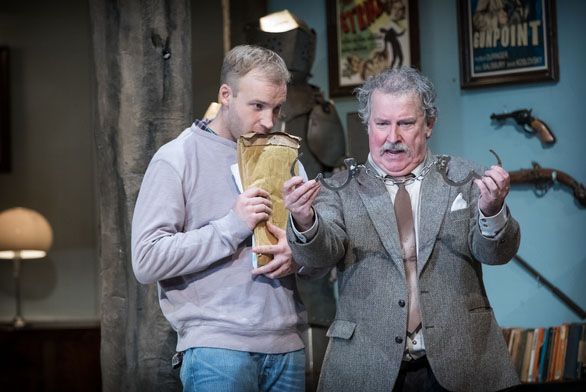
Deathtrap is overtly self-referential. The plot concerns the murderous intentions flying about between an older writer of stage thrillers, his wife, and an aspiring playwright attempting to get his play, itself called Deathtrap, off the ground. That play within the play directly maps onto the scenes acted out in front of us so the characters can tinker with the idea that we are seeing their edited versions of events, and provide witty commentary on the scenes as they have proceeded or at likely to proceed.
Writer Ira Levine was of course known for writing his suspenseful stage stories but the sinister aspects here are played for camp rather than for horror. Each act and violent moment on stage is accompanied by a thunderous boom – which does a good job of making the audience jump from their seats but this is inevitably accompanied by cathartic laughter. As far as chilling murder goes, the only real weapon in the plays arsenal is a jump scare or two.
And the structure of the staging has a bizarre way for paying homage to classics of the stage thriller genre. A screen descends during each scene transition so we see brief clips from the likes of Gaslight and Dial M for Murder. Beyond a distraction for the audience, this is a bit odd. Granted, Deathtrap is very reverential of the thriller canon, but on a certain level this rendition isn’t really interested in games of murder most foul.
This staging of Deathtrap works better as a farce than a thriller. The frequent metatextual jokes are a form of humour distinguishing it from a lot of its peers, and Paul Bradley as frivolous and vain writer-of-a-certain-age Sidney Bruhl is a source of well-placed quips. The plot even indulges in a cartoonish entrance of a Swedish celebrity psychic for a few scenes which is shamelessly hammy. And those grisly murders themselves work better as slapstick than as shocking acts of violence.
The play can be best summed up by its epilogue. Rather than ending on anything especially bloody or suspenseful, Deathtrap ends of a comical aside, once again bringing in our hammy psychic to lay it on thick. It ends on a note of pantomime which much better represents the sensibilities of the piece. Which is certainly fine if you want a play that is a decent laugh. ★★★☆☆ Fenton Coulthurst 18th October 2017

